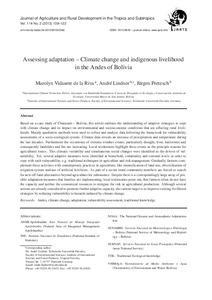| dc.date.accessioned | 2014-02-03T12:19:14Z | |
| dc.date.available | 2014-02-03T12:19:14Z | |
| dc.date.issued | 2013 | |
| dc.identifier.issn | 1612-9830 | |
| dc.identifier.uri | urn:nbn:de:hebis:34-2013081343342 | |
| dc.identifier.uri | http://hdl.handle.net/123456789/2013081343342 | |
| dc.language.iso | eng | |
| dc.publisher | Kassel University Press | ger |
| dc.rights | Urheberrechtlich geschützt | |
| dc.rights.uri | https://rightsstatements.org/page/InC/1.0/ | |
| dc.subject | Andes | eng |
| dc.subject | climate change | eng |
| dc.subject | adaptation | eng |
| dc.subject | vulnerability assessment | eng |
| dc.subject | traditional knowledge | eng |
| dc.subject.ddc | 630 | |
| dc.title | Assessing adaptation – Climate change and indigenous livelihood in the Andes of Bolivia | eng |
| dc.type | Aufsatz | |
| dcterms.abstract | Based on a case study of Charazani – Bolivia, this article outlines the understanding of adaptive strategies to cope with climate change and its impact on environmental and socioeconomic conditions that are affecting rural livelihoods. Mainly qualitative methods were used to collect and analyze data following the framework for vulnerability assessments of a socio-ecological system. Climate data reveals an increase of precipitation and temperature during the last decades. Furthermore the occurrence of extreme weather events, particularly drought, frost, hailstorms and consequently landslides and fire are increasing. Local testimonies highlight these events as the principle reasons for agricultural losses. This climatic variability and simultaneous social changes were identified as the drivers of vulnerability. Yet, several adaptive measures were identified at household, community and external levels in order to cope with such vulnerability; e.g. traditional techniques in agriculture and risk management. Gradually, farmers complement these activities with contemporary practices in agriculture, like intensification of land use, diversification of irrigation system and use of artificial fertilizers. As part of a recent trend community members are forced to search for new off-farm alternatives beyond agriculture for subsistence. Despite there is a correspondingly large array of possible adaptation measures that families are implementing, local testimonies point out, that farmers often do not have the capacity and neither the economical resources to mitigate the risk in agricultural production. Although several actions are already considered to promote further adaptive capacity, the current target is to improve existing livelihood strategies by reducing vulnerability to hazards induced by climate change. | eng |
| dcterms.accessRights | open access | |
| dcterms.bibliographicCitation | In: Journal of Agriculture and Rural Development in the Tropics and Subtropics. Kassel : Kassel University Press. - Vol. 114, No. 2 (2013), S. 109-122 | |
| dcterms.creator | Vidaurre de la Riva, Marolyn | |
| dcterms.creator | Lindner, André | |
| dcterms.creator | Pretzsch, Jürgen | |
| dc.description.everything | Gedruckte Ausg. im Verlag Kassel Univ. Press (www.upress.uni-kassel.de) erschienen. | ger |

